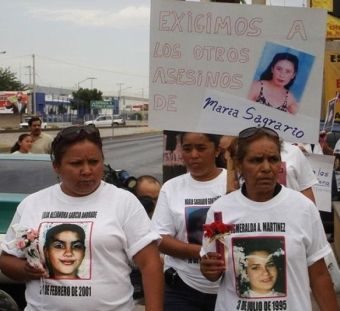
Publisher:
Bonnie King
CONTACT:
Newsroom@Salem-news.com
Advertising:
Adsales@Salem-news.com

~Truth~
~Justice~
~Peace~
TJP
Dec-29-2010 15:36

 TweetFollow @OregonNews
TweetFollow @OregonNews
2010: Turning Points in Chihuahua
Salem-News.comThis year international media devoted much reporting to the violence that engulfed Ciudad Juarez...
 Courtesy: internal-voices.blogspot.com |
(CIUDAD, Juarez) - If anything could be said about 2010 in Ciudad Juarez and the state of Chihuahua, it might be stated that any semblance of human rights flew out the window. Ushered in with the January murder of Juarez Valley human rights defender and army critic Josefina Reyes, the year drew to a close with the December slaying of activist Marisela Escobedo in the state capital of Chihuahua City, a crime which was captured on camera and transmitted across the world via the Internet.
Despite the immediate outrage provoked by the murder of Escobedo, who had spent more than two years protesting the disappearance and murder of her daughter in Ciudad Juarez, gunmen soon not only burned down the business of Escobedo’s male partner, but also kidnapped and murdered the man’s brother in the beleaguered border city.
Four of Escobedo’s surviving relatives took the hint and hightailed it across the Rio Bravo to El Paso, where they are expected to seek political asylum.
From January onward, the killing machine greased by the mechanics of the underworld roared non-stop. The slaughter of 14 young people in Ciudad Juarez’s Villas de Salvarcar neighborhood plunged the troubled city and Mexico into deepened crisis. Villas de Salvarcar popularized the word “youthcide” in the national vocabulary. Additional massacres at house parties, in bars and on public streets kept the public in a perpetual state of terror.
The Calderon administration unveiled a reconstruction plan for Ciudad Juarez, “We are all Juarez," and put the Federal Police instead of the army in charge of the city’s security. Yet the killing intensified, more people fled and the once-vibrant business/tourist and residential districts of Ciudad Juarez fell into an eye-grabbing decay.
Tourism Ministry statistics obtained by Ciudad Juarez’s Diario newspaper via Mexico’s Freedom of Information Act, reported that hotel occupancy plummeted from 447,034 people from January to October 2007 to 310,000 people during the same period in 2010.
The crash surely would have been much worse. Some establishments managed to stay afloat thanks to the Federal Police officers in need of lodging and the involuntary guests from across Mexico seeking US residency who were forced by the US government to stay in Ciudad Juarez while completing their approval process.
“We don’t have visitors coming for border tourism, or for shopping or for realizing cultural and sporting activities,” said Jorge Ruiz Carres, president of the Ciudad Juarez Hotel and Motel Association. “That type of visit is almost non-existent.”
Added to the factory lay-offs related to the global financial melt-down and the financial losses from extortion and robbery, the disappearance of tourist revenues from the local economy will be felt for a long time.
In 2010 international media devoted much reporting to the violence that engulfed Ciudad Juarez, blamed on the conflict between the Juarez and Sinaloa syndicates, but less international attention was given to the war also battering many other parts of the state of Chihuahua.
Nobody really knows for sure how many people perished in the course of the year. Citing official numbers from the Chihuahua state attorney general’s office, the Reforma news agency reported 5,212 people were murdered in the state between January 1 and December 19 of this year. The authorities blamed organzied crime for the bulk of killings, or 3,766 homicides, according to Reforma.
Violence hit hard the state capital of Chihuahua City, where 488 people were reportedly slain just between the months of May and August. In a city where extreme insecurity should imply at least a modicum of government security response, the brazen murder of Marisela Escobedo in front of Chihuahua state government offices and in plain public view was quite noteworthy.
The public security crisis had its repercussions on the political scene. In July, a minority of eligible Chihuahua voters elected Cesar Duarte of the Institutional Revolutionary Party to the governorship and chose Hector “Teto” Murguia (Ciudad Juarez mayor 2004-2007) for a second try at leading an embattled municipality.
As he was preparing to leave office, Ciudad Juarez Mayor Jose Reyes Ferriz created a stir by accusing outgoing Governor Jose Reyes Baeza of abandoning Ciudad Juarez to the wolves during the past three years.
Others criticized Reyes Ferriz for making untimely remarks and shirking his own responsibilities for the crisis. The atmosphere surrounding the political transition got uglier. Media savvy kidnappers snatched Mario Gonzalez, the brother of former Chihuahua State Attorney General Patricia Gonzalez, and released a series of videotaped “confessions” in which Gonzalez, surrounded by a group of armed, hooded men, detailed the alleged participation of his sister in murder and crime.
He named individuals supposedly connected to femicides, publicly tarred members of the political class-including former Governor Reyes Baeza- with accusations of illicit activities, and fueled new doubts among a public increasingly fed up with the political system.
A key player in the US Agency for International Development’s program to reform Mexico’s legal system, Patricia Gonzalez was also a partner in the efforts of the outgoing Richardson administration in neighboring New Mexico to expand legal, trade and other ties with Chihuahua.
Gonzalez challenged the credibility of statements her brother made under extreme duress and offered to sacrifice herself for his life.
No matter. Mario Gonzalez was executed and, despite the arrests of suspects allegedly behind the kidnap/murder, the scandal was largely forgotten amid fresh headlines publicizing an endless slew of new murders and crimes. Other crucial events occurred in 2010 that could influence developments in 2011. Perhaps most significantly, civil society began stirring and emerging as an independent voice in a socio-political melodrama dominated by business groups, politicians, urban and rural bosses, and government and private security forces.
In the northern Chihuahua farming town of Ascension, thousands of residents rose up against kidnappers, killed two suspected criminals, disarmed police accused of corruption and temporarily occupied city hall. In December, thousands of doctors and health care workers carried out a one-day work stoppage in Ciudad Juarez to protest criminal attacks on members of their profession and the overall public safety situation in their city.
Galvanized into action by the Villas de Salvarcar massacre, groups of youth, especially from the Autonomous University of Ciudad Juarez took to the streets to protest death and uphold life. In one such action on October 29, 19-year-old Jose Dario Alvarez was shot in the back by members of the Federal Police. Alvarez survived but was left physically impaired- possibly for life. The murder of Marisela Escobedo sparked a wave of protest across Mexico and the world, eliciting condemnations from the European Union and the Organization of American States’ Inter-American Commission on Human Rights.
Civil society organizations from the US, Honduras, Guatemala, El Salvador, Nicaragua, Costa Rica, Panama, Spain, Ireland, and the Phillipines joined hundreds of individuals and groups from Ciudad Juarez and Mexico in signing on to a December 20 statement that demanded a genuine investigation of the activist’s murder, protection for members of the Escobedo family and government compliance with the Inter-American Court of Human Rights' 2009 sentence related to the murders of women in Ciudad Juarez.
The statement read in part: “More than 50 million poor people, more than 7 million young people that don’t work or study, more than 3,000 murders this year in Ciudad Juarez, more than 10,000 orphans, hunger, and unemployment are definitive evidence that we have failed as a society.” Tracing Ciudad Juarez’s and Mexico’s troubles to corruption, myopia, authoritarianism, patronage politics, impunity, and an ineffective citizenry, the December 20 statement declared, “A society in peace is built on freedom, truth and justice.”
Widespread protests against the Escobedo assassination continued into the holiday season. In Chihuahua City, thousands of candles that had been placed at the murder scene to honor the fallen activist were mysteriously removed but then quickly replaced by enraged citizens and activists. Decorated with altars, the scene outside the state government complex soon resembled a shrine.
In California, activist groups including Centro Azteca, Amnesty International and the Mexican American Political Association plan a December 30 protest at the Mexican Consulate in San Francisco.
“We are demanding that the government of Mexico stop protecting murderers and drug cartels and instead stand up to protect the women, children and other innocents of Mexico,” read a flier announcing the protest.
A former Chihuahua state and federal lawmaker, columnist Victor Quintana wrote that Escobedo’s murder could be the proverbial straw that broke the camel’s back. Quintana contended that Marisela Escobedo’s relentless pursuit of justice was now spreading to many sectors in Ciudad Juarez and Chihuahua. Escobedo’s example, Quintana wrote, could inspire a new determination to “rebel for life.”
Expect more grassroots mobilizations in 2011. For instance, on January 29, near the date of the first anniversary of the Villas de Salvarcar slaughter, citizen groups in the El Paso-Ciudad Juarez area plan a joint, binational protest at the borderline dividing the common and bloodied land they inhabit.
Additional sources:
El Paso Times, December 29, 2010. Article by Adriana Gomez Licon.
Lapolaka.com. December 28, 2010. Proceso/Apro, December 27, 2010.
El Sur/Agencia Reforma, December 27, 2010. El Diario de Juarez, December 23, 2010. Arrobajuarez.com, December 22, 2010.
La Jornada, December 21, 22 and 24, 2010. Articles by Miroslava Breach, Ruben Villalpando and Victor Quintana.
Cimacnoticias.com, December 20 and 21, 2010.
Articles by Gladis Torres Ruiz, Lydia Cacho and Lucia Lagunes Huerta.
Frontera NorteSur (FNS): on-line, U.S.-Mexico border news
Center for Latin American and Border Studies
New Mexico State University
Las Cruces, New Mexico
Articles for December 28, 2010 | Articles for December 29, 2010 | Articles for December 30, 2010

Quick Links
DINING
Willamette UniversityGoudy Commons Cafe
Dine on the Queen
Willamette Queen Sternwheeler
MUST SEE SALEM
Oregon Capitol ToursCapitol History Gateway
Willamette River Ride
Willamette Queen Sternwheeler
Historic Home Tours:
Deepwood Museum
The Bush House
Gaiety Hollow Garden
AUCTIONS - APPRAISALS
Auction Masters & AppraisalsCONSTRUCTION SERVICES
Roofing and ContractingSheridan, Ore.
ONLINE SHOPPING
Special Occasion DressesAdvertise with Salem-News
Contact:AdSales@Salem-News.com


Salem-News.com:

Terms of Service | Privacy Policy

All comments and messages are approved by people and self promotional links or unacceptable comments are denied.
[Return to Top]
©2025 Salem-News.com. All opinions expressed in this article are those of the author and do not necessarily reflect those of Salem-News.com.